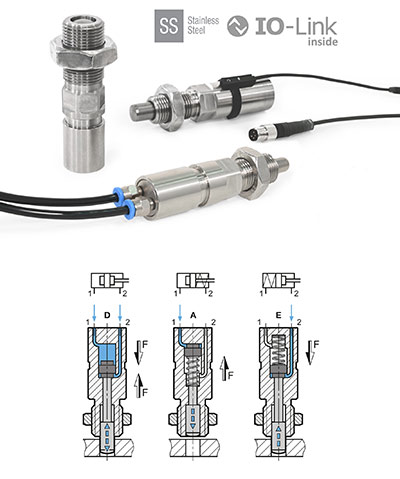JW Winco expands its indexing plungers’ range while adding new technical functionality. The latest addition, type GN 817.7, is pneumatically actuated and can be integrated seamlessly into automated processes thanks to state-of-the-art sensors.
 JW Winco offers a wide assortment of indexing plungers with various features. Their development team consistently succeeds at integrating new functionality that provides new application possibilities.
JW Winco offers a wide assortment of indexing plungers with various features. Their development team consistently succeeds at integrating new functionality that provides new application possibilities.
The most recent indexing plunger development is pneumatically actuated. In addition, the part also detects both end positions with just a single sensor. This makes the GN 817.7 a logical advancement over the manually operated indexing plunger GN 817.6. The GN 817.7 can replace the GN 817.6 without changing dimensions or signal processing. The new plunger can also be used in hard-to-reach locations and integrates into automated processes.
The position detection of GN 817.7 is proven magnet technology with added innovation. Not only are both end positions now detectable, but they can also be individually defined. Perform the sensor teaching directly on-site with a small operating element on the sensor, held in place by a clip and supported by a cable. There are even LEDs for visual feedback. The other option for teaching is to use the convenient IO-Link feature via the system control unit. This standardized interface makes teaching easy and allows immediate replacement in the case of faults, significantly reducing downtime.
]The high signals upon reaching the respective end positions are transmitted directly over the 4-pin M8 cable plug to the control unit of the system.
The GN 817.7 is made of robust stainless steel and is available in four plunger diameters and three functional variants. Type D is double-acting, meaning the plunger is pneumatically retracted and extended. Types A and E are single-acting, meaning the pneumatic actuation retracts the plunger in the case of type A and extends it in the case of type E. Note: The spring-loaded plunger always returns independently to its initial position if air pressure is lost.
The indexing plunger operates with pressures between 4 and 6 bar, while the IP 67-compliant sensor emits dc signals between 12 and 30 V.
JW Winco
www.jwwinco.com
Filed Under: Pneumatic Tips